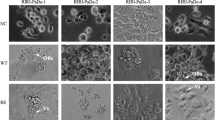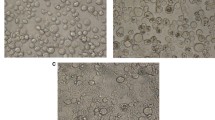Abstract
Although the baculovirus expression vector system (BEVS) is widely used in the production of recombinant proteins, only a few lepidopteran insect cell lines have been successfully used so far. This study aimed at evaluating the characteristics of an embryonic cell line from the American cockroach Periplaneta americana L., RIRI-PA1, and determining whether it could be used in recombinant protein expression. Wild type Autographa californica multiple nucleopolyhedrovirus (AcMNPV-wt) and green fluorescent protein (GFP)–replicating recombinant baculoviruses (AcMNPV-GFP) were used to infect RIRI-PA1 respectively, demonstrating that RIRI-PA1 cells could be infected by AcMNPV and express recombinant proteins. Within 24 h of infection with AcMNPV-GFP, the GFP expression was higher than that in Sf21 cells. Furthermore, the infection of RIRI-PA1 cells increased gradually (multiplicity of infection, 10) within 24 h, while in Sf21 cells, the infection only began to increase within 48 h. However, after exposure for 96–168 h, the virus progeny and recombinant protein production of RIRI-PA1 cells was lower than those of Sf21 cells. Western blotting revealed that RIRI-PA1 cells could express recombinant GFP, and the protein expression level positively correlated with the multiplicity of infection. In conclusion, this is the first report that a cell line from P. americana has shown susceptibility to infection from a baculovirus and likewise express recombinant protein. Although the yield of recombinant GFP was not as high as that of Sf21 cells, the results nonetheless showed that RIRI-PA1 had an infection rate advantage in the short term (within 24 h of infection), which is of great value for further development and utilization.








Similar content being viewed by others
References
Airenne KJ, Hu YC, Kost TA, Smith RH, Kotin RM, Ono C, Matsuura Y, Wang S, Yla-Herttuala S (2013) Baculovirus: an insect-derived vector for diverse gene transfer applications. Mol Ther : J Am Soc Gene Ther 21:739–749. https://doi.org/10.1038/mt.2012.286
Ali SM, Siddiqui R, Ong SK, Shah MR, Anwar A, Heard PJ, Khan NA (2017) Identification and characterization of antibacterial compound(s) of cockroaches (Periplaneta americana). Appl Microbiol Biotechnol 101:253–286. https://doi.org/10.1007/s00253-016-7872-2
Blissard GW, Theilmann DA (2018) Baculovirus entry and egress from insect cells. Annu Rev Virol 5:113–139. https://doi.org/10.1146/annurev-virology-092917-043356
Ding WF, Zhang X, Li X, Liu ZG, Xie SC, Feng Y (2018) Expression of three reporter genes in four cell lines developed from Papilio demoleus Linnaeus (Lepidoptera: Papilionidae). In Vitro Cell Dev Biol - Anim 54:194–199. https://doi.org/10.1007/s11626-017-0224-4
Feng LL, Zhang ZX (2007) Bionomics and integrated management of Perlaneta americana. J Cap Nomal Univ Nat Sci Ed 28:37–39. https://doi.org/10.3969/j.issn.1004-9398.2007.05.010
Gao BM, Li BZ, Yu JP, Hu YY, Zhangsun DT, Luo SL (2011) Expression of foreign genes in insect baculovirus expression systems. China Biotechnol 31:123–129. https://doi.org/10.13523/j.cb.20111120
Geisler C, Jarvis DL (2018) Adventitious viruses in insect cell lines used for recombinant protein expression. Protein Expr Purif 144:25–32. https://doi.org/10.1016/j.pep.2017.11.002
Geisler C, Mabashi-Asazuma H, Jarvis D (2015) An overview and history of glyco-engineering in insect expression systems. Glyco-Engineering 2015:131–152. https://doi.org/10.1007/978-1-4939-2760-9_10
Guo TQ, Wang JY, Guo XY, Wang SP, Lu CD (2005) Transient in vivo gene delivery to the silkworm Bombyx mori by EGT-null recombinant AcNPV using EGFP as a reporter. Arch Virol 150:93–105. https://doi.org/10.1007/s00705-004-0383-y
Hefferon KL (2003) ORF98 of Autographa californicanucleopolyhedrosisvirusis an auxiliary factor in late gene expression. Can J Microbiol 49:157–163. https://doi.org/10.1139/w03-022
Hitchman RB, Locanto E, Possee RD, King LA (2011) Optimizing the baculovirus expression vector system. Methods 55:52–57. https://doi.org/10.1016/j.ymeth.2011.06.011
Hu YC (2005) Baculovirus as a highly efficient expression vector in insect and mammalian cells. Acta Pharmacol Sin 26:405–416. https://doi.org/10.1111/j.1745-7254.2005.00078.x
Jiao Y, Wang J, Deng R, Yu X, Wang X (2019) AcMNPV-miR-3 is a miRNA encoded by Autographa californica nucleopolyhedrovirus and regulates the viral infection by targeting ac101. Virus Res 267:49–58. https://doi.org/10.1016/j.virusres.2019.05.004
Kassiri H, Kassiri A, Quaderi A (2014) Detection and prevalence rate of American cockroaches (Periplaneta americana) bacterial infections in human dwellings. Arch Clin Infect Dis 9:3–5. https://doi.org/10.5812/archcid.18737
Khodabandeh M, Shirani-Bidabadi L, Madani M, Zahraei-Ramazani A (2020) Study on Periplaneta americana (Blattodea: Blattidae) fungal infections in hospital sewer system, Esfahan City, Iran, 2017. J Pathog 2020:4296720. https://doi.org/10.1155/2020/4296720
Kost TA, Kemp CW (2016) Fundamentals of baculovirus expression and applications. Adv Exp Med Biol 896:187–197. https://doi.org/10.1007/978-3-319-27216-0_12
Lawson F, Johnson M (1971) Coxsackie A-12 in Periplaneta americana. Part III. Reappearance of the virus in salivary lands and other organs. J Kansas Entomol Soc 44:263–275
Li LJ, Wang MZ, Yuan TJ, Xu XH, Dad HA, Yu CL, Hou J, Peng LH (2019) The crude ethanol extract of Periplaneta americana L. stimulates wound healing in vitro & in vivo. Chin Med 14:33. https://doi.org/10.1186/s13020-019-0259-4
Li QJ, Wang ZG, Liu Q, Xie Y, Hu HL (2018) Research status of Periplaneta americana with analyses and prospects of key issues. China J Chin Mater Med 43:1507–1516. https://doi.org/10.19540/j.cnki.cjcmm.20180201.009
Ling T, Yu L, Bai MQ (2014) Research progress and application of insect cell-baculovirus expression vector system. Prog Microbiol Immunol 42:70–78. https://doi.org/10.13309/j.cnki.pmi.2014.02.016
Luo SL, Huang XJ, Wang Y, Jiang RW, Wang L, Bai LL, Peng QL, Song CL, Zhang DM, Ye WC (2014) Isocoumarins from American cockroach (Periplaneta americana) and their cytotoxic activities. Fitoterapia 95:115–120. https://doi.org/10.1016/j.fitote.2014.03.004
Meng MJ, Li TL, Li CY, Li GX (2008) A suspended cell line from Trichoplusia ni (Lepidoptera): characterization and expression of recombinant proteins. Insect Sci 15:423–428. https://doi.org/10.1111/j.1744-7917.2008.00229.x
Meng XQ, Zheng GL, Zhao CD, Wan FH, Li CY (2017) A cell clone strain from Mythimna separata (Lepidoptera: Noctuidae) highly susceptible to Autographa californica multiple nucleopolyhedrovirus (AcMNPV) and M. separata NPV (MsNPV). In Vitro Cell Dev Biol Anim 53:646–650. https://doi.org/10.1007/s11626-017-0166-x
Murhammer DW (2016) Baculovirus and insect cell expression protocols. Humana Press, New York. https://doi.org/10.1007/978-1-4939-3043-2
Nguyen T, Chen X, Chai J, Li R, Han X, Chen X, Liu S, Chen M, Xu X (2020) Antipyretic, anti-inflammatory and analgesic activities of Periplaneta americana extract and underlying mechanisms. Biomed Pharmacother 123:109753. https://doi.org/10.1016/j.biopha.2019.109753
Schütz A, Scheller N, Breinig T, Meyerhans A (2006) The Autographa californica nuclear polyhedrosis virus AcNPV induces functional maturation of human monocyte-derived dendritic cells. Vaccine 24:7190–7196. https://doi.org/10.1016/j.vaccine.2006.06.044
Shi XZ, Jarvis DL (2007) Protein N-Glycosylation in the baculovirus-insect cell system. Curr Drug Targets 8:1116–1125. https://doi.org/10.2174/138945007782151360
Si Y, Zhu YC, Song XY, Luo YN, Cheng LF (2020) Advances in the development of vaccines using insect cell baculovirus expression vector system. J Trop Med 20:1117–1120. https://doi.org/10.3969/j.issn.1672-3619.2020.08.032
Smagghe G, Goodman CL, Stanley D (2009) Insect cell culture and applications to research and pest management. In Vitro Cell Dev Biol Anim 45:93–105. https://doi.org/10.1007/s11626-009-9181-x
Steele KH, Stone BJ, Franklin KM, Fath-Goodin A, Zhang X, Jiang H, Webb BA, Geisler C (2017) Improving the baculovirus expression vector system with vankyrin-enhanced technology. Biotechnol Prog 33:1496–1507. https://doi.org/10.1002/btpr.2516
Sun N, Ding WF, Liu ZG, Zhang X, Li X, Feng Y (2019) Characterization and recombinant protein expression in the clonal strain RIRI-PX1-C2 4 derived from Papilio xuthus (Lepidoptera: Papilionidae). Acta Entomol Sin 62:304–311. https://doi.org/10.16380/j.kcxb.2019.03.004
Sun YQ, Li M, He FQ (2004) Bionomics and integrated management of five species of cockroaches. Entomol Knowl 41:216–222. https://doi.org/10.3969/j.issn.0452-8255.2004.03.006
Taticek RA, Choi C, Phan S, Palomares LA, Shuler ML (2001) Comparison of growth and recombinant protein expression in two different insect cell lines in attached and suspension culture. Biotechnol Prog 17:676–684. https://doi.org/10.1021/bp010061g
Tomiya N, Narang S, Lee YC, Betenbaugh MJ (2004) Comparing N-glycan processing in mammalian cell lines to native and engineered lepidopteran insect cell lines. Glycoconj J 21:343–360. https://doi.org/10.1023/B:GLYC.0000046275.28315.87
Wilde M, Klausberger M, Palmberger D, Ernst W, Grabherr R (2014) Tnao38, high five and Sf9--evaluation of host-virus interactions in three different insect cell lines: baculovirus production and recombinant protein expression. Biotechnol Lett 36:743–749. https://doi.org/10.1007/s10529-013-1429-6
Wu QS, Li YY (2020) Research progress on key technologies and applications of insect baculovirus expression vector system. Int J Virol 27:348–352. https://doi.org/10.3760/cma.j.issn.1673-4092.2020.04.021
Yun J, Hwang JS, Lee DG (2017) The antifungal activity of the peptide, periplanetasin-2, derived from American cockroach Periplaneta americana. Biochem J 474:3027–3043. https://doi.org/10.1042/BCJ20170461
Zhang H, Zhang YA, Qin QL, Wang YZ, Qu LJ, Li X, Miao L, Yin YX, Zhang AJ, Wen FY (2007) Advances in establishment of insect cell lines. Acta Entomol Sin 50:834–839. https://doi.org/10.3321/j.issn:0454-6296.2007.08.012
Zhang X, Feng Y, Ding WF, Chen XM, Wang CY, Ma T (2012) Characterization of a new insect cell line that is derived from the neonate larvae of Papilio xuthus (Lepidoptera: Papilionidae) and its susceptibility to AcNPV. Tissue Cell 44:137–142. https://doi.org/10.1016/j.tice.2011.11.007
Zhang X, Feng Y, Ding WF, Li X, Xie SC (2018) Establishment of an embryonic cell line from the American cockroach Periplaneta americana (Blattaria: Blattidae) and a preliminary study of telomerase activity changes during the culturing process. In Vitro Cell Dev Biol Anim 54:129–135. https://doi.org/10.1007/s11626-017-0223-5
Zhao Y, Yang A, Tu P, Hu Z (2017) Anti-tumor effects of the American cockroach, Periplaneta americana. Chin Med 12:1–6. https://doi.org/10.1186/s13020-017-0149-6
Zou Y, Zhang M, Zeng D, Ruan Y, Shen L, Mu Z, Zou J, Xie C, Yang Z, Qian Z, Xu R, Li S, Kang Q, Zou H, Zhao S, Liu L, Wang K, Wang X, Zhang X (2020) Periplaneta americana extracts accelerate liver regeneration via a complex network of pathways. Front Pharmacol 11:1–12. https://doi.org/10.3389/fphar.2020.01174
Acknowledgements
We would like to acknowledge the China Center for Type Culture Collection for Sf21 cells, and Dr. Ping Tang from Jiangsu University, China, for AcMNPV-wt.
Funding
This work was supported by grants from the Science and Technology Program of Yunnan Provincial Science and Technology Department (No: 2019FB043).
Author information
Authors and Affiliations
Corresponding author
Ethics declarations
Ethics statement and conflict of interest
This report does not contain any studies with human participants or animals. The research was conducted in the absence of any commercial or financial relationships that could be construed as a potential conflict of interest.
Rights and permissions
About this article
Cite this article
Ma, C., Zhang, X., Li, X. et al. An embryonic cell line from the American cockroach Periplaneta americana L. (Blattaria: Blattidae) exhibits susceptibility to AcMNPV. In Vitro Cell.Dev.Biol.-Animal 58, 278–288 (2022). https://doi.org/10.1007/s11626-021-00628-9
Received:
Accepted:
Published:
Issue Date:
DOI: https://doi.org/10.1007/s11626-021-00628-9




